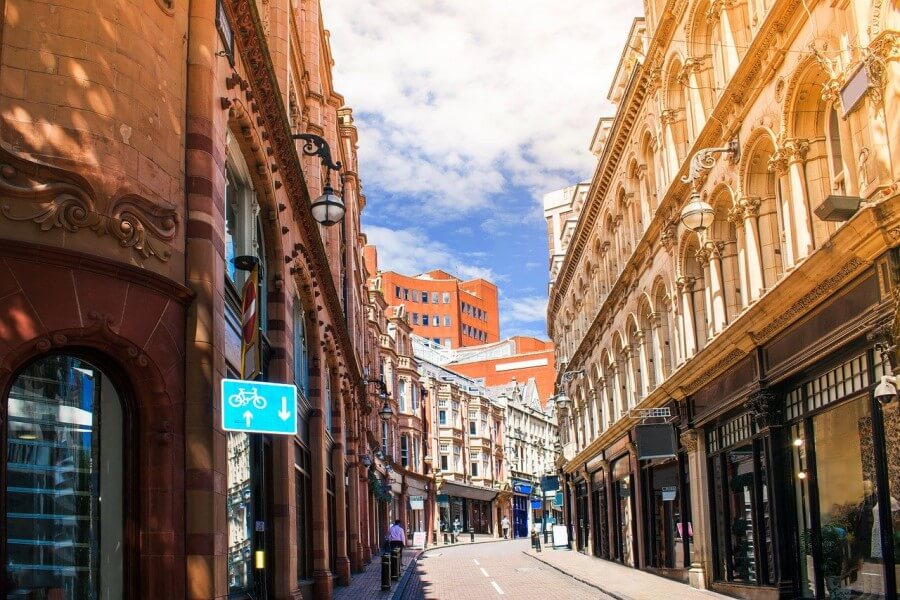 In this blog, Anne Green, Rebecca Riley, Alex Smith, Ben Brittain and Hannes Read examine the long-term impact of Covid-19 on business districts. How can they continue to be successful places attracting business and people and contributing to vibrant city centres?
In this blog, Anne Green, Rebecca Riley, Alex Smith, Ben Brittain and Hannes Read examine the long-term impact of Covid-19 on business districts. How can they continue to be successful places attracting business and people and contributing to vibrant city centres?
This blog is the summary from the Future Business District report – visit the project page.
On the 17th of November, we will be holding an event to discuss the findings of the Future Business District Report – Find out more and book a place.
Pandemics in history have had social, economic and political impacts and have spurred developments in medicine. Cities have survived and re-emerged in a relatively strong position in the wake of these pandemics. Contemporary economic geographers argue that the ‘agglomeration advantages’ of cities are likely to remain even given the existence of alternatives to face-to-face working for many office workers because of the importance of proximity in collaborative knowledge creation (especially in finance and business services, high tech and media clusters) and due to shortcomings in the extent to which video-conferencing can replicate for in-person interaction. The dense urban labour markets of large cities, and their associated friendship networks and other amenities, are attractive to many highly educated young people.
The longer the disruption of the Covid-19 pandemic lasts, the greater the likelihood that some shifts in activity associated with the initial response to lockdown result in more radical, permanent shifts.
Birmingham and the lockdown
Prior to the onset of the Covid-19 pandemic, Birmingham enjoyed a period of sustained economic growth. Birmingham city centre was transformed physically and economically, with a thriving business, professional and financial services (BPFS) sector driving high levels of business tourism, alongside vibrant hospitality and retail sectors.
In March 2020 the instruction to work from home and the shutdown of hospitality and retail in the first national lockdown brought rapid and radical change to city centre business districts. Since then the economy and society has seen phases of opening up, closing down and opening up once again. Individuals and firms have had to respond in real-time to a developing health and economic situation. Cities have overcome pandemics and shocks before, but the recent period has no recent precedent.

The Future Business District Study
As part of its response to the radical changes being experienced, the Colmore Business District (Colmore BID) established the Future Business District Study to inform long-term recovery from the Covid-19 pandemic and offer policy directions on best practice for central business districts across the UK. It commissioned a team from City-REDI (University of Birmingham) and the West Midlands Combined Authority to deliver a research programme, supported by an independent Advisory Panel and a range of partners.
The project focused on prospects for Birmingham’s city centre business district in the medium- and longer-term, addressing two questions:
- What is the likely long-term impact of the Covid-19 pandemic on city centre business districts?
- How can we ensure they remain successful as places to attract businesses and people and contribute to vibrant city centres?
So what did the study reveal?
Trends shaping the future business districts
From the research and engagement phases the following key trends were apparent:
- Digital transformation of the workplace and tech disruption will continue to impact business models and where and how work is done.
- Hybrid working is here to stay for many (not all) – two-three days working in the office and three-two days working from home (or elsewhere), especially in sectors such as business, professional and financial services, driven by broader ‘life’ considerations as well as ‘work’ ones.
- Access to talent is ever more critical and there is an increased demand for skills and jobs that emphasise human interaction – networking, problem solving, collaboration, selling, creating and innovating.
- Future business districts will need to be even more focused around connections and culture – a place to connect, interact and collaborate and to enjoy urban experiences.
- Safety – on transport, in public spaces and at offices – has risen up the agenda considerably. Meanwhile, encouraging commuters back onto public transport systems – that feel safe and meet the needs of new working patterns – is a major challenge.
- Demand for recognising social value, climate change and inclusivity among consumers and employees will continue to rise.
Future Scenarios
Four scenarios were developed that analysed possible outcomes based on changes in employment in the city centre and in footfall associated with culture, hospitality and retail.
The preferred vision Is one which sees increasing employment in the city centre and increasing culture, hospitality and retail footfall. It would avoid the business district becoming a ghost town or being solely focussed on work. This would encourage workers in the BPFS sector to return to the city centre not solely for work but for the wider benefits of city life. This requires a diverse offer to meet the needs of office workers operating on a hybrid working model, alongside the needs of consumers of cultural, retail, entertainment and leisure activities. It also requires action to positively address inequalities and lack of inclusion and mitigate against spatial and economic overheating.
 Themes for Action
Themes for Action
The key findings from the interviews, and reflections on them, were distilled into one overarching theme and six further themes around which policy-makers, researchers, central and local government, as well as wider business partners and other stakeholders, can join together.
The Space Between – This overarching theme highlights how a high-quality public realm, plus hospitality and retail venues, together with green and open spaces, make the city centre attractive to businesses and individuals, and support well-being. The ‘space between’ is the hidden, unrecognised space utilised on an ongoing basis – including transport, public realm, green space, cultural/ entertainment space – which is essential to the growth, performance and activity of the ‘space within’ businesses. It provides opportunities for workers, residents and visitors to relax, connect and recharge.
- Connections and Culture – A place to meet remains the big idea behind successful cities and their central business districts; office workers and consumers are likely to be driven back into city centres by the need to connect with others via networking and socialising. More collaboration and meeting spaces and leisure/cultural experiences will be needed to keep people returning to the city to connect and exchange.
- Agile and Flexible – There is a considerable appetite amongst office workers for more flexible and hybrid working. Workspaces and employees are becoming more agile, so the business environment needs to support this trend
- Colmore Collaborates – The prominence of hybrid working in the short- to- medium-term is likely to have a significant impact on how floor space demands will evolve and how workers interact with the office as a social space, calling for different types of space and placing prominence on the ‘office as a destination’ and on exploiting opportunities for growing collaborative workspaces to be utilised by more users.
- On the Move – There is an opportunity to re-shape an integrated transport system, with greater reliance on active travel modes and the evolution of public transport to accommodate the changing needs of the day-time and night-time economies.
- Safe and Sound – The priority people attach to safety on transport, in offices and in public places has grown, the future business district will need to meet rising expectations.
- Open to All – The emphasis is on opening and enhancing the city centre business district to more businesses and more people, and to harness green and open spaces, so resonating with concerns about climate issues, inclusivity and well-being.
Recommendations
Businesses need to:
- Understand the impact their business decisions have on place and how their offices interact with the space they are in and make this an active part of business case development and corporate social responsibility activities.
- Work with local businesses to help stimulate demand for their services, ideally through a focus on employee benefits, career development, networking and training.
- Lobby and invest in better transport, safety and external space development in order to create an environment workers and visitors want to come back to – or visit for the first time.
The public sector needs to:
- Encourage the development of a city with green space, open places and a high-quality public realm that promotes well-being through providing safe spaces for people to come together, as well as venues to enjoy leisure and participate in culture.
- Rethink transport in light of the Covid-19 pandemic and work with transport operators and businesses to design systems that promote worker return and engagement with the city.
- Promote the city, dispel negative images and attract new investments, visitors and workers which complement and fit with the focus of the city centre BIDs.
There is a greater need than was formerly the case for a flexible BID model that can be a city curator that promotes and accelerates:
- Being the place for hybrid working: Supporting businesses to adapt to a hybrid working model and its implications. This entails backing both core BPFS businesses in the district but also taking account of the spillover effects on retail, hospitality and accommodation services.
- Being the centre of experience for employees: Developing the experience portfolio of the city centre business district – attract former city centre workers back and engaging a new diverse workforce with the enjoyment of interaction and experience of place and activities.
Being the place to network and grow: Developing networks and communities – with a focus on recruitment, training, career development and opportunities for innovation for a diverse workforce in a hybrid world.
This blog was written by Professor Anne Green, Rebecca Riley, Alex Smith, Ben Brittain and Hannes Read, City-REDI / WMREDI, University of Birmingham.
Disclaimer:
The views expressed in this analysis post are those of the authors and not necessarily those of City-REDI or the University of Birmingham.
